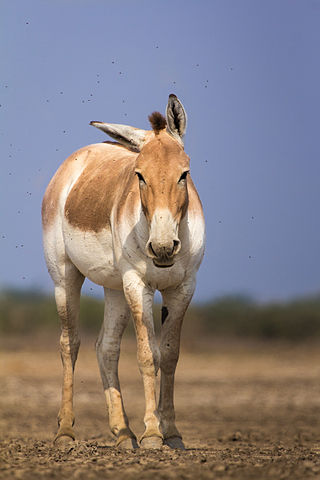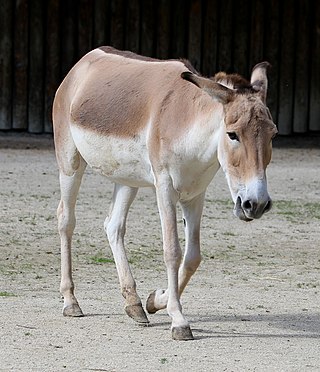Related Research Articles

The onager, also known as hemione or Asiatic wild ass, is a species of the family Equidae native to Asia. A member of the subgenus Asinus, the onager was described and given its binomial name by German zoologist Peter Simon Pallas in 1775. Five subspecies have been recognized, one of which is extinct.

The Mongolian wild ass, also known as Mongolian khulan, is the nominate subspecies of the onager. It is found in southern Mongolia and northern China. It was previously found in eastern Kazakhstan and southern Siberia before being extirpated there through hunting. As of 2015, the Mongolian wild ass is listed as Near Threatened by the IUCN. Current population estimates are approximately 42,000 individuals in Mongolia and around 5,000 individuals in Northern China.

Asinus is a subgenus of Equus that encompasses several subspecies of the Equidae commonly known as wild asses, characterized by long ears, a lean, straight-backed build, lack of a true withers, a coarse mane and tail, and a reputation for considerable toughness and endurance.
Endangered mammals of India are the mammal species in India that are listed as threatened in the International Union for Conservation of Nature and Natural Resources (IUCN) Red List of Threatened Animals

The Syrian wild ass, less commonly known as a hemippe, an achdari, or a Mesopotamian or Syrian onager, is an extinct subspecies of onager native to the Arabian peninsula and surrounding areas. It ranged across present-day Iraq, Palestine, Israel, Iran, Jordan, Saudi Arabia, Syria, and Turkey.

The Indian wild ass, also called the Indian onager or, in the local Gujarati language, Ghudkhur and Khur, is a subspecies of the onager native to South Asia.

The wildlife of Pakistan comprises a diverse flora and fauna in a wide range of habitats from sea level to high elevation areas in the mountains, including 195 mammal, 668 bird species and more than 5000 species of Invertebrates. This diverse composition of the country's fauna is associated with its location in the transitional zone between two major zoogeographical regions, the Palearctic, and the Oriental. The northern regions of Pakistan, which include Khyber Pakhtunkhwa and Gilgit Baltistan include portions of two biodiversity hotspot, Mountains of Central Asia and Himalayas.

The Turkmenian kulan, also called Transcaspian wild ass, Turkmenistani onager or simply the kulan, is a subspecies of onager native to Central Asia. It was declared Endangered in 2016.

The Persian onager, also called the Persian wild ass or Persian zebra, is a subspecies of onager native to Iran (Persia). It is listed as Endangered, with no more than 600 individuals left in the wild and only 30 individuals living within North American institutions.
References
- ↑ "Missing birds". 25 December 2022.
- ↑ "Extinction of Wildlife Species in Pakistan". 22 January 2019.
- ↑ Durant, S.; Mitchell, N.; Ipavec, A. & Groom, R. (2015). "Acinonyx jubatus". IUCN Red List of Threatened Species . 2015: e.T219A50649567.
- ↑ IUCN SSC Antelope Specialist Group (2016). "Antilope cervicapra". IUCN Red List of Threatened Species . 2016: e.T1681A50181949.
- ↑ Brook, S.M.; Donnithorne-Tait, D.; Lorenzini, R.; Lovari, S.; Masseti, M.; Pereladova, O.; Ahmad, K. & Thakur, M. (2017). "Cervus hanglu". IUCN Red List of Threatened Species . 2017: e.T4261A120733024.
- ↑ Williams, C.; Tiwari, S.K.; Goswami, V.R.; de Silva, S.; Easa, P.S.; Kumar, A.; Baskaran, N.; Yoganand, K. & Menon, V. (2020). "Elephas maximus". IUCN Red List of Threatened Species . 2020: e.T7140A45818198.
- ↑ Kaczensky, P.; Lkhagvasuren, B.; Pereladova, O.; Hemami, M.; Bouskila, A. (2016). "Equus hemionus ssp. khur". IUCN Red List of Threatened Species . 2016: e.T7963A3144616.
- ↑ Bauer, H.; Packer, C.; Funston, P. F.; Henschel, P. & Nowell, K. (2016). "Panthera leo". IUCN Red List of Threatened Species . 2016: e.T15951A115130419.
- ↑ Goodrich, J.; Lynam, A.; Miquelle, D.; Wibisono, H.; Kawanishi, K.; Pattanavibool, A.; Htun, S.; Tempa, T.; Karki, J.; Jhala, Y. & Karanth, U. (2015). "Panthera tigris". IUCN Red List of Threatened Species . 2015: e.T15955A50659951.
- ↑ Ellis, S. & Talukdar, B. (2019). "Rhinoceros unicornis". IUCN Red List of Threatened Species . 2019: e.T19496A18494149.
- ↑ Duckworth, J. W.; Kumar, N.S.; Pokharel, C.P.; Baral, H. S. & Timmins, R. J. (2015). "Rucervus duvaucelii". IUCN Red List of Threatened Species . 2015: e.T4257A22167675.